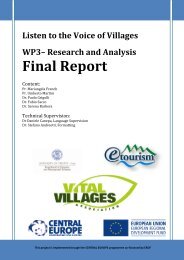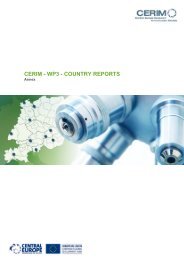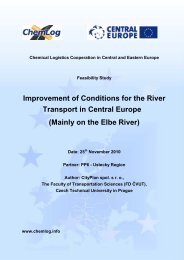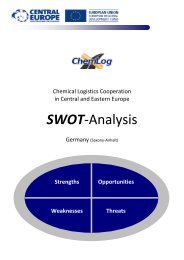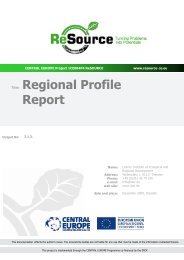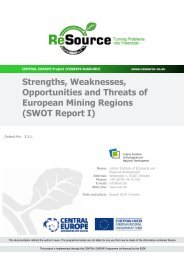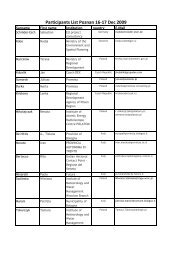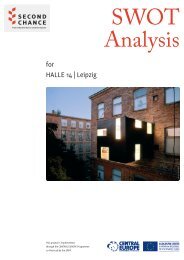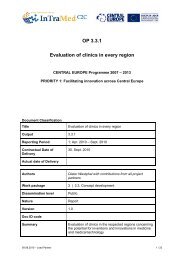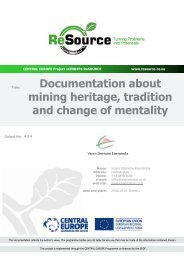Creating Transformation: Ten principles for the - Central Europe
Creating Transformation: Ten principles for the - Central Europe
Creating Transformation: Ten principles for the - Central Europe
Create successful ePaper yourself
Turn your PDF publications into a flip-book with our unique Google optimized e-Paper software.
The rehabilitation of <strong>for</strong>mer mines, industrial sites and brownfields are challenging<br />
tasks. The legacy of mining provides special problems, but also very unique<br />
opportunities <strong>for</strong> <strong>the</strong> regional development. This was <strong>the</strong> starting point of an<br />
Internationale Bauausstellung (International Building Exhibition), a well known<br />
planning instrument in Germany. The article describes <strong>the</strong> background and aims of<br />
IBA and gives an outlook to future rehabilitation quality standards.<br />
1. Background: The region Lausitz-Spreewald<br />
For ten years <strong>the</strong> organization, International Bauausstellung (IBA) Fürst-Pückler-<br />
Land, has been active in shaping <strong>the</strong> post-mining landscape in Brandenburg (in<br />
eastern Germany). This region was known as <strong>the</strong> energy district of <strong>the</strong> <strong>for</strong>mer<br />
German Democratic Republic because of its huge deposits of lignite. The excavation<br />
of lignite began around 150 years ago. Initially, mining was below ground but was<br />
later carried out by means of huge open-cast mines. Mining brought o<strong>the</strong>r industries<br />
such as briquette factories, power stations, coke plants and related branches of<br />
industry. A total of seventeen open-cast mines were in operation in 1989. Subsequent<br />
to <strong>the</strong> radical political change in 1989/1990, <strong>the</strong> majority of <strong>the</strong> open-cast mines and<br />
industries were abruptly shut down. Today <strong>the</strong> swedish energy firm, Vattenfall,<br />
operates five open-cast mines and three power stations in <strong>the</strong> region.<br />
As a result of this deindustrialization, <strong>the</strong> region has experienced a high rate of<br />
unemployment up to 25 Percent. The German government has devised new<br />
employment strategies <strong>for</strong> a limited time, so called job-creating measures. Also, <strong>the</strong><br />
whole political and social structure in <strong>the</strong> <strong>for</strong>mer GDR has changed, e.g. <strong>the</strong> school<br />
and <strong>the</strong> health care systems. The <strong>for</strong>mer Chancellor Helmut Kohl promoted<br />
“prosperous landscapes,” but in reality, <strong>the</strong> population in <strong>the</strong> eastern part of Germany<br />
has been shrinking. In 2005, <strong>the</strong> German Spatial Planning office documented <strong>the</strong><br />
simultaneity of growth and shrinkage in Germany. In Lusatia, <strong>the</strong> population has<br />
shrunk by about 20 percent since 1990.<br />
Normally, <strong>the</strong> recultivation of post-mining landscapes is an integral part of <strong>the</strong><br />
production process. For <strong>the</strong> closed-down lignite industry from GDR, legal mining<br />
responsiblity fell to <strong>the</strong> government as proprietor of <strong>the</strong> lignite business that could<br />
not be privatized. A company, LMBV (Lausitzer und Mitteldeutsche<br />
Bergbauverwaltungsgesellschaft), was set up to deal with this task. The german<br />
government allocated spezial funds <strong>for</strong> <strong>the</strong> recultivation of <strong>the</strong> post-mining<br />
landscapes. A total of just under ten billion euros was budgeted yet. Also, IBA has<br />
been financed by this budget.<br />
2. IBA as an planning instrument<br />
In Germany, building exhibitions are a well known, project oriented planning<br />
method that provides new impulses within a limited time, guarantees a high-quality<br />
standard of (landscape) architecture and leads to innovative designs.<br />
The IBA Fürst-Pückler-Land Association, supported by four rural districts in<br />
Brandenburg as well as <strong>the</strong> city of Cottbus and promoted by <strong>the</strong> Federal Land<br />
Brandenburg, has been <strong>the</strong> heart of a network connecting <strong>the</strong> people involved on site<br />
Seite 2 von 8




